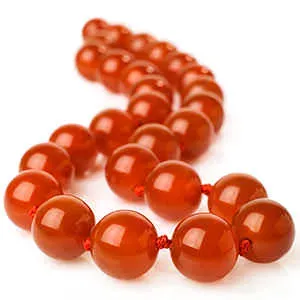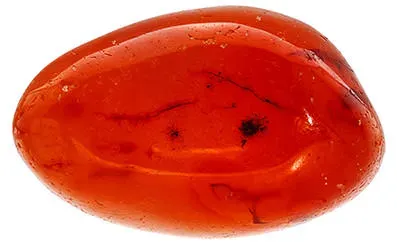 Carnelian is a form of
Carnelian is a form of ![]() quartz, and the birthstone for the month of August. It is also sometimes called Cornelian. The name carnelian comes from the Latin word carneus, which means fleshy, a reference to the color of the stone. Carnelian has a long history. Over 4500 years ago, Sumerian and Egyptian craftsmen were making jewelry set with the stone. Ancient Romans and Greeks also valued the stone, which they used for intaglios. Carnelian has also been popular for signet rings. While in Egypt, Napoleon picked up an octagonal carnelian on the battlefield, and returned from Egypt with this stone, wearing it all the time, and then leaving it to his nephew.
quartz, and the birthstone for the month of August. It is also sometimes called Cornelian. The name carnelian comes from the Latin word carneus, which means fleshy, a reference to the color of the stone. Carnelian has a long history. Over 4500 years ago, Sumerian and Egyptian craftsmen were making jewelry set with the stone. Ancient Romans and Greeks also valued the stone, which they used for intaglios. Carnelian has also been popular for signet rings. While in Egypt, Napoleon picked up an octagonal carnelian on the battlefield, and returned from Egypt with this stone, wearing it all the time, and then leaving it to his nephew.
 Carnelian is an inexpensive gemstone. It is usually cut as cabochons, or used for beads and cameos. It is common to find carnelian in antique jewelry. Carnelian can range in color from reddish orange to brownish, yellow, red, or pink. The various shades of red depend on the amount of iron oxide present in each stone. Stones can be faintly banded, or uniform in color. Carnelian rates a.6.5 on the hardness scale, and is transparent to sub translucent. It is often confused with
Carnelian is an inexpensive gemstone. It is usually cut as cabochons, or used for beads and cameos. It is common to find carnelian in antique jewelry. Carnelian can range in color from reddish orange to brownish, yellow, red, or pink. The various shades of red depend on the amount of iron oxide present in each stone. Stones can be faintly banded, or uniform in color. Carnelian rates a.6.5 on the hardness scale, and is transparent to sub translucent. It is often confused with ![]() sard, however sard's color is never as intense as carnelian's. Most of the carnelian found on the market today is stained
sard, however sard's color is never as intense as carnelian's. Most of the carnelian found on the market today is stained ![]() chalcedony from Brazil or Uruguay. Stones are usually heat treated to enhance their color. Carnelian can be found in India, Japan, Madagascar, Russia, Poland, Iceland, Slovakia, Peru and Romania. Major deposits are found on the lower Narbada river, in western India; Queensland, Australia; Bohemia, in the Czech Republic; Franche-Compte, in France; the Black Forest and Bavaria, in Germany; Cornwall, England, and Ratnapura, in southwest Sri Lanka. In the United States, carnelian is found in Connecticut, Florida, New Jersey, Tennessee and Washington. The very best stones however, come from India, where they are transformed from brown to red by being placed in the sun.
chalcedony from Brazil or Uruguay. Stones are usually heat treated to enhance their color. Carnelian can be found in India, Japan, Madagascar, Russia, Poland, Iceland, Slovakia, Peru and Romania. Major deposits are found on the lower Narbada river, in western India; Queensland, Australia; Bohemia, in the Czech Republic; Franche-Compte, in France; the Black Forest and Bavaria, in Germany; Cornwall, England, and Ratnapura, in southwest Sri Lanka. In the United States, carnelian is found in Connecticut, Florida, New Jersey, Tennessee and Washington. The very best stones however, come from India, where they are transformed from brown to red by being placed in the sun.
 Throughout history, there have been many beliefs in the positive attributes of carnelian. In ancient Egypt, carnelian rings were worn to eliminate bad tempers, hatred, jealousy and anger. Back then; the stone was also used to protect the dead during their journey to the afterlife. In Renaissance magic, carnelian was engraved with a picture of a warrior or a sword and placed in the home to protect it from storms. This amulet was also carried as a protection. Carnelian was also worn to prevent skin diseases, insanity, nosebleeds and blood diseases. It was also believed to be able to stop nightmares.
Throughout history, there have been many beliefs in the positive attributes of carnelian. In ancient Egypt, carnelian rings were worn to eliminate bad tempers, hatred, jealousy and anger. Back then; the stone was also used to protect the dead during their journey to the afterlife. In Renaissance magic, carnelian was engraved with a picture of a warrior or a sword and placed in the home to protect it from storms. This amulet was also carried as a protection. Carnelian was also worn to prevent skin diseases, insanity, nosebleeds and blood diseases. It was also believed to be able to stop nightmares.
 Today, carnelian is thought to be a stone of great value to those who are shy and must speak in public, which is actually one of American's #1 fears. G. F. Kunz, a turn of the century gemologist and historian declared that the wearing of carnelians is recommended to those who have a weak voice or are timid in speech, for the warm-colored stone will give them the courage they lack so that they will speak both boldly and well. Carnelian is also used to promote peace and harmony, and to rid the wearer of depression. It promotes courage, motivation, creativity, concentration, patience, and self trust. Physically, carnelian has been said to be able to stimulate metabolism, heal lower back problems, rheumatism, arthritis, and neuralgia.
Today, carnelian is thought to be a stone of great value to those who are shy and must speak in public, which is actually one of American's #1 fears. G. F. Kunz, a turn of the century gemologist and historian declared that the wearing of carnelians is recommended to those who have a weak voice or are timid in speech, for the warm-colored stone will give them the courage they lack so that they will speak both boldly and well. Carnelian is also used to promote peace and harmony, and to rid the wearer of depression. It promotes courage, motivation, creativity, concentration, patience, and self trust. Physically, carnelian has been said to be able to stimulate metabolism, heal lower back problems, rheumatism, arthritis, and neuralgia.